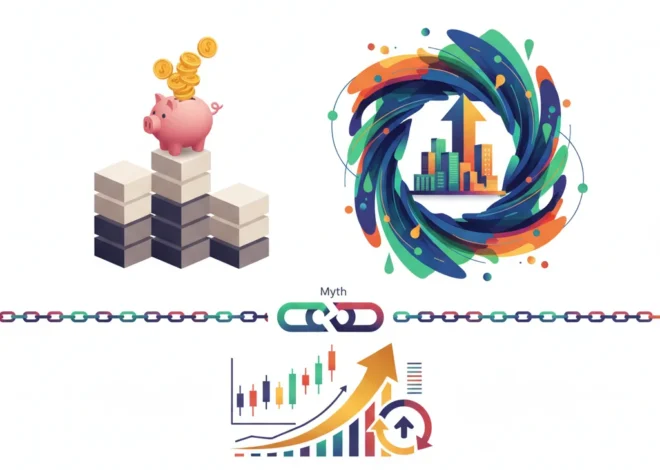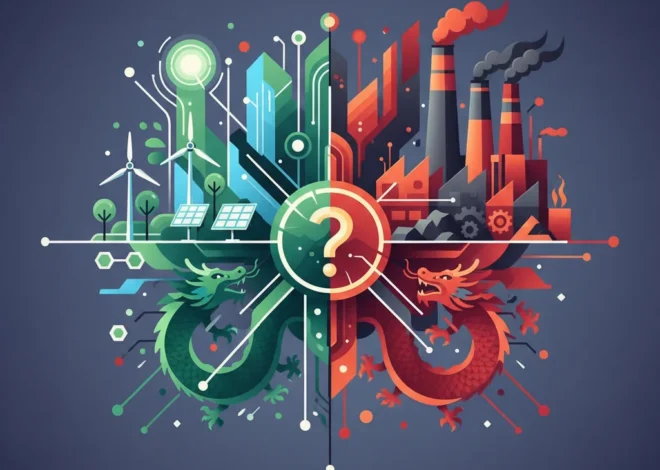
The Green Revolution’s Hidden Handbrake: Why Old Money Is Stifling New Growth
The Great Green Paradox: We Have the Tech, So Why the Delay?
The global push towards a sustainable future presents a tantalizing paradox. We are living through an unprecedented era of technological innovation. Solar panels are cheaper and more efficient than ever, battery storage capacity is skyrocketing, and electric vehicles are rapidly moving from niche to mainstream. The technological building blocks for a green economy are largely in place. Yet, the transition feels frustratingly slow, hampered by unseen forces that seem to defy market logic. Why?
The answer, according to Nobel-winning economists, lies not in the laboratory or the engineering department, but in the corridors of power. It’s a story about economics, influence, and a powerful concept known as “creative destruction.” The real battle for a green future isn’t just about inventing new technologies; it’s about dismantling the old economic structures that stand in their way. And right now, those old structures are fighting back—hard.
This isn’t merely an environmental issue; it’s a fundamental challenge to our understanding of economic growth, a critical consideration for anyone involved in finance, investing, and long-term business strategy. The winners of the next century will be those who understand this dynamic, while those who ignore it risk becoming relics of a bygone, carbon-intensive era.
Schumpeter’s Gale: The Engine of All Economic Progress
To grasp the challenge, we must first understand the engine of capitalist growth: creative destruction. Coined by the legendary economist Joseph Schumpeter, it describes the “process of industrial mutation that incessantly revolutionizes the economic structure from within, incessantly destroying the old one, incessantly creating a new one.”
Think of it as an economic gale. It’s the force that saw automobiles replace the horse and buggy, digital streaming obliterate the video rental store, and smartphones make a whole suite of single-use gadgets obsolete. This process is messy, disruptive, and often painful for those on the losing end. But it is the very source of dynamism, productivity gains, and improved living standards in a market economy. In the world of investing, betting on the agents of creative destruction—the innovators and disruptors—is often the path to exponential returns on the stock market.
The green transition is poised to be the largest wave of creative destruction in human history. It requires replacing the fossil fuel-based energy, transportation, and industrial systems that have powered the global economy for over a century with new, sustainable alternatives. This should, in theory, unleash a tidal wave of innovation, investment, and new growth. But a powerful handbrake is being applied.
The Incumbent’s Dilemma: Lobbying Against the Future
The core of the problem, as highlighted in research by Nobel laureate Philippe Aghion, is that the “old guard”—the large, incumbent firms in carbon-intensive sectors—are not passive observers. They are actively using their immense financial resources and political influence to slow the gale of creative destruction to a gentle breeze.
How? Through sophisticated and relentless lobbying. These firms push for regulations that favor their existing business models. They advocate for subsidies that are ostensibly “green” but are structured to flow to established players rather than nimble startups. They fight tooth and nail against policies that would level the playing field, such as a meaningful carbon tax, which would make their polluting activities more expensive and green alternatives more competitive. According to the article, this lobbying effort by big business is a primary factor holding back the growth needed for a successful green transition (source).
This creates a deeply uneven playing field, stifling the very competition that drives innovation. A brilliant new battery technology or a breakthrough in green hydrogen might struggle to get funding and scale if the regulatory and subsidy environment is tilted in favor of legacy energy giants. Below is a comparison of the competing forces in this economic struggle.
| Characteristic | Incumbent Firms (Old Guard) | Green Innovators (New Entrants) |
|---|---|---|
| Primary Goal | Protect existing assets and market share | Disrupt the market with new technology/models |
| Key Strengths | Capital, political influence, lobbying power, scale | Agility, technological edge, lower overhead, focus |
| Approach to Policy | Lobby for subsidies, tax breaks, and regulations that create barriers to entry | Advocate for open competition, carbon pricing, and R&D support |
| Innovation Focus | Incremental improvements to existing (often carbon-intensive) processes | Radical, breakthrough technologies (e.g., next-gen solar, fusion, direct air capture) |
| Risk to the Economy | Creates stagnation, “zombie” industries, and slows overall growth | High failure rate for individual firms, but drives sector-wide progress |
This table illustrates the fundamental conflict at the heart of the green transition. It’s not just a technological race; it’s a political and economic power struggle. The strategies that made incumbent firms successful in the 20th-century economy are now the very tools they are using to prevent the 21st-century economy from being born.
Gold Shatters the ,000 Ceiling: What's Driving the Surge and What It Means for Your Investments
The initial reaction from big banks was dismissal, followed by intense lobbying to ring-fence their activities. But ultimately, the value proposition of fintech was too strong. Now, the entire banking sector has been forced to innovate or integrate. We may even see decentralized technologies like blockchain further accelerate this, creating more transparent and efficient financial systems. The green transition is this same story on a planetary scale. The question for investors and policymakers is whether we can learn from these past disruptions to accelerate this critical one, rather than letting the old guard dictate the pace of our own survival.
The Right Fuel for the Fire: Policies for Innovation, Not Protection
If protecting incumbents is the problem, what is the solution? The answer isn’t to simply throw money at the problem. As Aghion and his colleagues have shown, poorly designed policies can make things worse. Subsidies, if not carefully targeted, can be captured by the very companies with the best lobbyists, effectively becoming a tool to entrench the status quo rather than foster new growth.
Instead, effective policy must focus on one thing: unleashing competition. This involves a multi-pronged approach:
- Price the Negative Externality: The most efficient tool, favored by a vast majority of economists, is a robust and predictable carbon tax. This forces companies to pay for their pollution, making cleaner alternatives immediately more attractive and creating a powerful, market-wide incentive for innovation. It’s not about picking winners; it’s about making the polluters pay.
- Spur New Entrants: Governments should direct R&D funding and tax credits towards startups and new technologies, not just established players. This helps level the playing field and ensures that the most promising ideas get a chance to compete, a point emphasized by the economists cited in the original analysis.
- Enforce Antitrust Laws: A crucial, often overlooked tool is strong competition policy. Preventing carbon-intensive giants from buying up promising green startups simply to shelve their technology, or from using their market power to crush smaller rivals, is essential for maintaining a dynamic and innovative ecosystem.
The goal of government policy should not be to manage a slow, comfortable decline for legacy industries, but to clear the path for their successors. It is about creating the fertile ground from which the next generation of world-leading companies will grow.
The £15 Billion Question: Is the UK Car Finance Scandal the Next PPI?
An Investor’s Guide to the Great Disruption
For those involved in finance and investing, this framework is more than just an academic theory; it is a vital lens through which to view the future of the global economy. Understanding the dynamics of creative destruction in the green transition offers clear, actionable insights for portfolio strategy and risk management.
- Look Beyond the ESG Label: Many large, incumbent energy firms have impressive ESG (Environmental, Social, and Governance) scores. But it’s crucial to look under the hood. Is their “green” spending focused on genuine innovation and business model transformation, or is it a defensive measure designed to protect their core, polluting business? True long-term value will likely be found in the disruptors, not the incumbents paying lip service to change.
- Identify the Enablers: The biggest winners may not be the most obvious ones. Investing in the “picks and shovels” of the green revolution—companies that provide essential materials (like lithium), software (for grid management), or financial technology (for green project finance)—can be a powerful strategy.
- Price in Political Risk: The lobbying battle creates significant political risk. An investment in a legacy fossil fuel company isn’t just a bet on commodity prices; it’s a bet on that company’s continued ability to influence policy in its favor. As public and political pressure for climate action mounts, that is an increasingly risky wager.
- Embrace Volatility in Trading: The path of creative destruction is never smooth. For active traders, the conflict between incumbents and innovators will create significant volatility in the stock market, presenting opportunities for those who can correctly identify the long-term trends amid the short-term noise.
Ultimately, the green transition represents a massive reallocation of capital. The trillions of dollars currently locked into the old carbon economy will need to move. Investors who align themselves with the forces of creative destruction are positioning themselves on the right side of history and finance.
Beyond the Hype: Why Verisure's €3.2bn IPO is a Game-Changer for European Finance
Conclusion: Choosing Dynamism Over Stagnation
The journey to a sustainable economy is at a critical juncture. The technology is within our grasp, but the path is blocked by the economic and political inertia of the past. The insights from Nobel-winning economics are a stark reminder that progress is not inevitable; it must be fought for. It requires that we embrace the disruptive, chaotic, and ultimately revitalizing process of creative destruction.
For policymakers, this means having the courage to implement policies that foster competition, even when it threatens powerful incumbents. For business leaders, it means choosing to be the disruptor rather than the disrupted. And for investors, it means recognizing that the greatest risk is not the transition itself, but being left behind with the assets of a fading economic paradigm. The choice is between a future of managed decline and protected stagnation, or one of dynamic, sustainable, and truly green growth.


